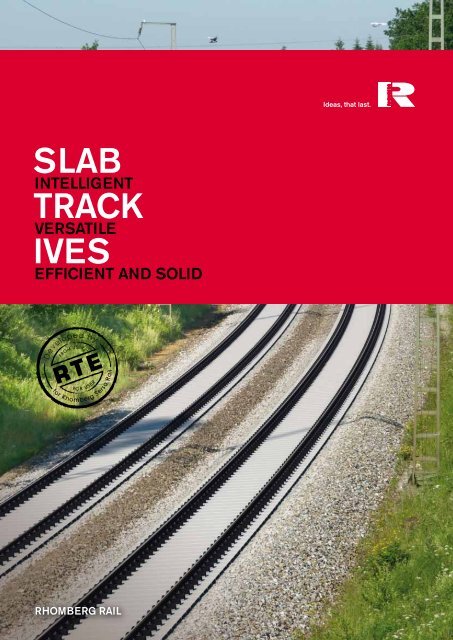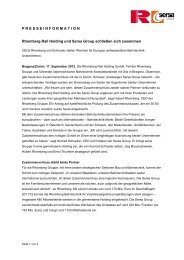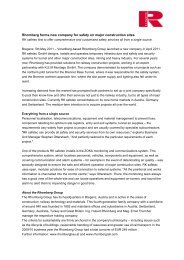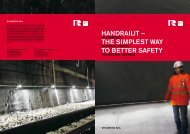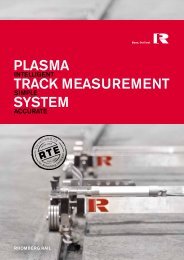Download Slab track Ives
Download Slab track Ives
Download Slab track Ives
You also want an ePaper? Increase the reach of your titles
YUMPU automatically turns print PDFs into web optimized ePapers that Google loves.
<strong>Slab</strong><br />
Intelligent<br />
<strong>track</strong><br />
Versatile<br />
IVES<br />
Efficient and solid<br />
RHOMBERG RAIL
IVES – SYNTHESIS<br />
OF DESIGN AND<br />
CONSTRUCTION<br />
EXPERIENCE<br />
Rhomberg Rail can call on years of theoretical<br />
and practical know-how in the various types of slab<br />
<strong>track</strong> construction. And the result is IVES, the latest<br />
development in ballastless <strong>track</strong> construction.<br />
IVES stands for intelligent, versatile, efficient, solid.<br />
All these characteristics are embodied in this integrated<br />
concept, which is based on an analysis of the advantages<br />
and disadvantages of various long-term tested slab <strong>track</strong><br />
techniques.<br />
PHILOSOPHY AND CONSTRUCTION<br />
During the development of IVES, the various possible components,<br />
materials and working processes were investigated and<br />
matched to one another to create an overall system that works<br />
well and is cost-efficient. The result is a technically and economi-<br />
cally optimised form of construction that reduces not only costs in<br />
ordinary fields of application of slab <strong>track</strong> (high-speed <strong>track</strong> in highly<br />
developed regions) but also allows a considerably wider range of<br />
uses of this technology as an alternative to ballast roadbed.<br />
Load capacity<br />
The load capacity<br />
requirement decreases<br />
as the stresses from<br />
the railway loads<br />
decrease from<br />
the top<br />
downwards.<br />
The amount<br />
of work involved in<br />
building the <strong>track</strong> decreases<br />
from the bottom upwards.<br />
Amount of work<br />
Accuracy<br />
The influence of<br />
manufacturing<br />
accuracy on vehicle<br />
<strong>track</strong> guidance<br />
decreases<br />
from top<br />
downwards.<br />
Overall quality<br />
The requirements<br />
for overall quality are<br />
consistently fulfilled.<br />
The IVES efficiency principle:<br />
Load capacity, accuracy and amount of work are ideally matched to the respective requirements. In terms of cost and effort,<br />
IVES involves as much as necessary and as little as possible of these resources in all areas of construction.<br />
Basic principles of IVES
EFFICIENT USE OF COMPONENTS AND MATERIALS<br />
One of the key ideas in the development of IVES was the efficient and deliberate use of components and materials with qualities that<br />
match their respective requirements. Likewise, manufacturing methods and transport and construction processes take into account the<br />
objective of increasing efficiency. The results are constituent parts that are quick and easy to produce, transport, handle and install.<br />
RAIL FASTENING SYSTEM<br />
The DFF 304 system is based on proven and approved components.<br />
The support points were modified so that they provide<br />
a form of direct fastening (grouted into the precast element) to<br />
fulfil the highest demands for long-term pull-out resistance and<br />
convenience of installation.<br />
Rail fastening DFF 304<br />
STRUCTURAL ELEMENTS<br />
These components carry the grouted-in rail fastenings and<br />
transfer the vehicle load into the base layer. As they do not<br />
directly determine the rail geometry, they can be manufactured<br />
in the appropriate quality without adopting too high a<br />
technical standard so that costs can be kept relatively low.<br />
Structural element<br />
GROUTING IN THE RAIL FASTENINGS<br />
A high-strength, rapid-hardening grouting mortar is used so<br />
that grouting the rail fastenings into the precast concrete units<br />
is an easy, quick and reliable on-site process that achieves a<br />
high-quality result.<br />
BASE LAYER<br />
The base layer is preferably constructed of road asphalt using<br />
conventional methods. As a rule, the base layer should<br />
have dowels inserted to create a connection capable of<br />
transferring shear from the structural elements into the<br />
base layer.
INSTALLATION<br />
TECHNIQUE:<br />
SIMPLE,<br />
RELIABLE,<br />
QUICK,<br />
FLEXIBLE<br />
The success of the IVES installation<br />
concept is based on the following:<br />
• Combination of bottom-up and top-down installation principles<br />
• Efficient distribution of the accuracy and amount of work<br />
involved<br />
• Efficient use of material and component qualities<br />
• Appropriate simplification of components<br />
Installation sequence<br />
CONSTRUCTION OF BASE LAYER<br />
The base layer, preferably consisting of asphalt, is normally<br />
laid with a road finisher in accordance with the bottom-up<br />
principle. The accuracy requirements are lower than most<br />
road construction projects and should be quite easy to<br />
achieve.<br />
PLACING THE STRUCTURAL ELEMENTS<br />
The position and depth of the structural elements are roughly<br />
defined by the preinserted dowels and the properties of the<br />
base layer. Their uniformly level surface allows a wide variety<br />
of vehicles to run on them directly after placing.<br />
Asphalt base layer with dowels<br />
FORMATION OF THE TRACK GRID<br />
The <strong>track</strong> grid, consisting of rails and <strong>track</strong> fastenings, is<br />
formed using proven techniques. The plastic dowel bolts of<br />
the rail fasteners project into the recesses in the top of the<br />
transverse structural elements.<br />
FINE ADJUSTMENT OF THE TRACK GRID<br />
The <strong>track</strong> grid is brought to its precise position and level.<br />
The top-down principle allows all the inaccuracies from the<br />
previous steps to be compensated for later, even at a very<br />
late stage in the work. The recesses in the top of the transverse<br />
structural elements allow relatively large ranges of<br />
horizontal and vertical corrective adjustments.<br />
Placed structural elements<br />
FIXING THE RAIL SUPPORT POINTS<br />
The voids between the rail fastenings and the structural<br />
elements are filled with high-strength mortar. The intention<br />
here is to permanently fix the <strong>track</strong> grid exactly in the desired<br />
position.<br />
Structural elements with <strong>track</strong> grid
UNIVERSAL APPLICATION<br />
Different railway types – same <strong>track</strong> system:<br />
The IVES slab <strong>track</strong> system can be used for almost any type<br />
of permanent way (standard gauge, rapid transit, low- or highspeed<br />
railway). Because of its simple form of construction,<br />
any required modifications can be made quickly and easily.<br />
Changes to the <strong>track</strong> configuration – easily done<br />
by sticking to the basic principles<br />
The simple design of the prefabricated concrete units,<br />
in particular their shape and precise dimensions, allows<br />
each component to be specifically adjusted to suit any<br />
<strong>track</strong> configuration.<br />
Application as longitudinal<br />
structural elements on bridges<br />
THE IVES SYSTEM AT A GLANCE<br />
Intelligent:<br />
• Flexibility of adaptation to suit the state of technology<br />
available at the installation site through its relatively simple<br />
and functional construction: structural layers and elements<br />
can be generally constructed on site, wherever run-of-themill<br />
road-building and manufacture of simple prefabricated<br />
units can take place.<br />
• Flexibility of tailoring the amount of work involved to suit<br />
project resources through a simple step-by-step approach to<br />
installation: can be constructed equally well using low-tech<br />
equipment or highly mechanised plant.<br />
Versatile:<br />
• Can be used for virtually all types of permanent way (standard<br />
gauge, rapid transit, low- and high-speed railways).<br />
• The simple design of the structural elements allows individual<br />
components to be specifically modified to suit the<br />
<strong>track</strong> configuration.<br />
Efficient:<br />
• Greater availability of components thanks to the simple,<br />
standardised design of the structural elements.<br />
• Universal component design (or any necessary<br />
adjustments can be done at relatively little cost).<br />
• High degree of mechanisation is possible due to<br />
simple step-by-step installation.<br />
• Interruption of construction is no problem, as the<br />
installation steps are not time-dependent.<br />
• Short waiting times between each installation step<br />
• Track under construction can be used for transport<br />
purposes at almost every stage of installation<br />
• Early defined point in time when the finished <strong>track</strong> is<br />
capable of supporting loads<br />
Solid:<br />
• Consistently high quality<br />
• Efficient, high-grade materials<br />
• Proven materials and components
Since 2001 RTE’s developments have expanded the competence<br />
profile of the Rhomberg Rail Group in the area of railway <strong>track</strong><br />
systems and measuring technology. The team consists of a wide<br />
range of experts, which include construction engineers, surveyors,<br />
electronic engineers and software engineers. They develop and<br />
optimise complex systems for a variety of specialised disciplines.<br />
image processing, and microprocessor control systems) for<br />
outside companies. Our office in Salzburg is fully equipped with<br />
a test <strong>track</strong> and the necessary infrastructure to support CAD software<br />
and electronic developments.<br />
Marketing and sales is carried out by Rhomberg Rail Consult GmbH.<br />
The core competences of RTE Technologie GmbH are the development<br />
of <strong>track</strong> surveying systems and slab <strong>track</strong> railway systems.<br />
All these developments are characterised by their practical application<br />
as all systems have been tested and applied to in-house<br />
projects for the Rhomberg Rail Group. RTE Technologie GmbH<br />
also develops solutions in other technical areas (mechanical<br />
construction, software development, geometry tasks, digital<br />
Rhomberg Rail Consult GmbH<br />
info@rhombergrail.com<br />
Mariahilfstrasse 29<br />
6900 Bregenz/Austria<br />
Ph. +43 5574 403-0<br />
Engelbert Weiss Weg 2/B/4<br />
5020 Salzburg/Austria<br />
Ph. +43 662 421066<br />
www.rhombergrail.com


